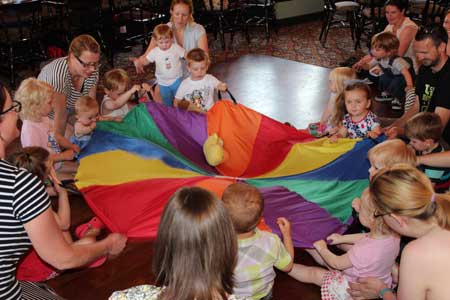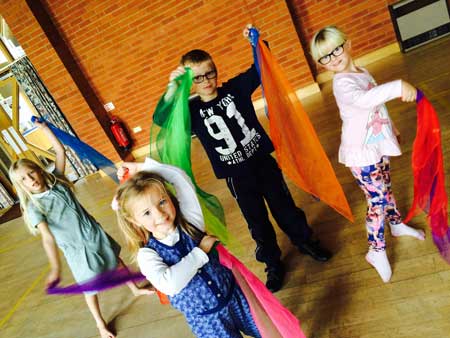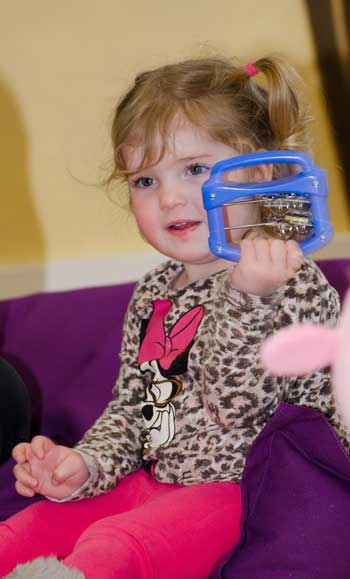Top tips on helping your child learn a new lingo
[caption id="attachment_2517" align="alignright" width="450"] You don't need to know a second language yourself for your child to learn one![/caption] Have you ever been in awe of children who can speak fluently in more than one language? Well, the truth is that most youngsters have an innate advantage when it comes to learning a second tongue, and can pick up a new lingo far more quickly than we can. With the European Day of Languages approaching on the 26th September, we started wondering about the best ways to teach your little ones a new language. To find out how it’s done, we caught up with Anna Neville, the brains behind Kidslingo - a children’s franchise business that teaches French and Spanish to over 6,000 babies, toddlers and primary school kids throughout the UK. ‘Learning a foreign language as a youngster has bags of benefits, from developing problem-solving skills[1] and improving brain structure[2], to increasing cultural awareness and academic performance[3]. Not only that, it can be a fun activity that helps children and parents make new friends. Don’t worry though – you don’t have to know a second language yourself for your child to learn one. There’s plenty you can do to help them without you even knowing a word. So, if you’re ready to start your youngster on a language learning journey - On y va! (Let’s go !).
You don't need to know a second language yourself for your child to learn one![/caption] Have you ever been in awe of children who can speak fluently in more than one language? Well, the truth is that most youngsters have an innate advantage when it comes to learning a second tongue, and can pick up a new lingo far more quickly than we can. With the European Day of Languages approaching on the 26th September, we started wondering about the best ways to teach your little ones a new language. To find out how it’s done, we caught up with Anna Neville, the brains behind Kidslingo - a children’s franchise business that teaches French and Spanish to over 6,000 babies, toddlers and primary school kids throughout the UK. ‘Learning a foreign language as a youngster has bags of benefits, from developing problem-solving skills[1] and improving brain structure[2], to increasing cultural awareness and academic performance[3]. Not only that, it can be a fun activity that helps children and parents make new friends. Don’t worry though – you don’t have to know a second language yourself for your child to learn one. There’s plenty you can do to help them without you even knowing a word. So, if you’re ready to start your youngster on a language learning journey - On y va! (Let’s go !).
- Make it fun
Before we go any further, this is the most important tip of them all. However you teach your child another language, the most important thing is to make it fun! When a youngster feels like they’re being taught something rigidly, they can lose interest very quickly. Try and weave in learning naturally, making fun your number one priority. You’ll see far more progress, we promise!
- Start them early
Have you ever wondered why children seem to have a natural, sponge like ability to absorb new information? This is because the younger you are, the easier it is for your brain to build new pathways that increase the capability to learn new things. As we age, this ability diminishes, and learning something new takes far more time and effort. We’d always recommend starting to teach your child another language as early in life as possible, babies included!
- Turn up the music
Music is a central part of our culture and can be a powerful learning tool. It’s thought that by listening to words that are sung, and by singing them back, they become better ingrained in the memory. Investing in some high-quality foreign language CDs or MP3s can be a particularly useful way of teaching your child a new language, especially if the music is based on nursery rhymes they already know. It’s interesting to know that even when children don’t understand what’s being sung, music can help set linguistic patterns and develop listening skills, which helps create the early formation of language. This isn’t just true for toddlers and young children, it even applies to babies in utero.
- Use repetition
Children learn through repetition and by listening to a foreign language in context. Carry out an activity you enjoy doing together, such as painting, emphasizing the names of the items and the colours you’re using. Next time you paint a picture, refer to the same items, like ‘paintbrush’ and ‘paper’ in another language, and make sure you repeat the words a number of times while showing them the items you’re referring to. [caption id="attachment_2518" align="aligncenter" width="450"] Most of the time, kids don't even realise they're picking up a new language as they're too busy having fun![/caption]
Most of the time, kids don't even realise they're picking up a new language as they're too busy having fun![/caption]
- Use drama
Pairing exaggerated gestures and facial expressions with vocabulary improves understanding and makes words and phrases more memorable – so the sillier you can be the better! While we’re not all budding thespians, the beauty of doing this in the privacy of your own home is that you can be as wacky as you like without feeling embarrassed.
- Invest in some learning aids
There are plenty of learning aids on the market, but investing in just a couple of quality pieces should be all your child needs to get them started. At Kidslingo, we don’t just use our own Singalong CD range, we’re also fond of the One Third Stories range, that gradually introduces another language through its Clockwork Methodology™, and Lil’ollo, that focuses on providing a rich visual experience to enhance memory recall through a range of games and products, such as flashcards.
- Download language apps
Children are known for having short attention spans, so using technology can help them learn. While it’s not a good idea to use technology as your sole educational tool, it can form an important part of the mix. Downloading fun and exciting language apps can mean your little one can practice whenever they like, and that you’ll have something educational to hand in case you need to entertain them while out and about.
- Say what you’re doing
Talking out your actions, such as saying ‘I am walking to the kitchen’ or ‘I am cutting an apple’ helps your youngster pick up language clues from linking the activity with the vocabulary. In turn, this helps develop language skills, contextualises phrases and improves their memory recall. This isn’t just a beneficial tip for teaching a new language, it can be very effective in helping kids understand English words and grammar too. One of our favourites is climbing the stairs and counting at the same time. [caption id="attachment_2516" align="aligncenter" width="350"] Children learn through repetition and by listening to a foreign language in context.[/caption]
Children learn through repetition and by listening to a foreign language in context.[/caption]
- Join a class
As a parent, you’ll be inundated with a range of classes to send your baby, toddler or young child to. But if you find the right kids language classes, you’ll never look back. At Kidslingo, we combine music, visual clues, drama, games, songs and music, which all make the perfect backdrop for effective learning. Most of the time, kids don’t even realise they’re picking up a new language as they’re too busy having fun! Whatever the ability level, all children take away something positive from the sessions and share the common experience of learning something new together. Classes start from £4 per session. To find your local class, please visit www.kidslingo.co.uk.
- Have reasonable expectations
Your child won’t suddenly become a multilingual prodigy overnight, but getting them used to the sounds and nuances of a new language can be just enough to lay the foundations for later on in life. So even though you might not be having a fluent conversation in Spanish with your youngster anytime soon, if you say ‘goodnight’ at bedtime, he or she is sure to figure out what you mean.’
The European Day of Languages is jointly organized by the Council of Europe and the European Union and celebrates the 6,000+ languages spoken across the globe. It also promotes language learning and the numerous benefits it can bring. Do you teach your child a foreign language? If so, what do you find works? Let us know on Twitter or Facebook! [1] https://search.proquest.com/openview/d7e761d361d819908752822689725dd9/1.pdf?pq-origsite=gscholar&cbl=27755 [2] http://www.pnas.org/content/112/5/1334 [3] http://www.sde.ct.gov/sde/lib/sde/PDF/Curriculum/Curriculum_Root_Web_Folder/BenefitsofSecondLanguage.pdf